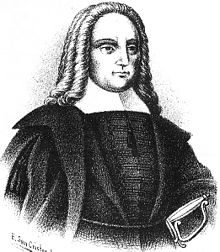Carmine Nicolao Caracciolo
Carmine Caracciolo , Imperial Prince ( principe ) of Santo Buono, Duke ( duque ) of Castel di Sangro, Markgraf ( marqués ) of Bucchianico, Graf ( condensing ) of Esquiavi, Santo Vido and Capracota, Baron of Monteferrante , Spanish Grande (for the middle names are also variants of the spelling of Nicolas / Nicola / Niccolo) (* June 5, 1671 in Bucchianico near Naples ; † 1727 near Naples) was a Spanish colonial administrator of Italian origin, who was Viceroy of Peru from 1717 to 1720 .
Life
Caracciolo came from a family of the Neapolitan nobility, who served as imperial princes of the Holy Roman Empire . His father Marino Caracciolo was the fourth imperial prince of Santo Buono. Carmine Caracciolo married Constanza Ruffo, the daughter of the Duke of Bragnara, with whom he had 14 children. His interest in science and art brought him to the "academy" of Luis Francisco de la Cerda, Duke of Medinacelli, the Spanish viceroy of Naples from 1695 to 1702. Carmine Caracciolo was sent to Rome and Venice as Naples ambassador .
In 1707, under Wirich Philipp Graf Daun , the Habsburgs conquered the Kingdom of Naples, which had previously belonged to Spain, in the War of the Spanish Succession . Caracciolo sided with the (later victorious) Bourbons .
In 1711 he settled in Spain at the court of King Philip V , who in 1713 appointed him Viceroy of Peru. It was not until the end of 1715 that he embarked from Cádiz for South America. On the crossing, his wife died shortly after the birth of his fourteenth child; the death evidently triggered a lasting depression in Caracciolo . In January 1716 he reached Cartagena , where he ordered the (direct and unpaid) flourishing trade with the French via Portobelo as smuggling to be stopped. He continued these efforts as viceroy and imposed draconian penalties on trade with foreigners.
In October 1716 he solemnly moved into Lima and took over the official duties as viceroy from Diego Morcillo Rubio de Auñón , the archbishop of Charcas .
In 1717, by order from Madrid, the administrative districts of the Real Audiencias of Bogotá , Quito and Panamá were separated from the viceroyalty of Peru and merged into a newly founded viceroyalty of New Granada . This repeatedly led to quarrels about who was responsible, which were exacerbated by conflicts between secular and ecclesiastical jurisprudence.
In 1719 and 1720 up to 60,000 people died in typhoid epidemics.
A solar eclipse was observed in Lima on August 15, 1719 .
Caracciolo suggested to the king, the system of Encomienda to reform and in particular the commitment of the local people, forced labor to do away with. However, the proposals were rejected.
After three years in office, Caracciolo asked the crown to replace him so that he could return to Europe. The court complied with this request and named the Archbishop of Charcas, Diego Morcillo, as his successor. He took office on January 26, 1720. Caracciolo returned to Europe and reached Cadiz in mid-1721.
With the end of the Spanish War of Succession, he was able to return to his lands in southern Italy, where he died in 1727.
literature
- Manuel de Mendiburu (1805-1885): Diccionario histórico-biográfico del Perú . tape 2 . Imprenta J. Francisco Solis, Lima 1876, p. 160-164 ( Cervantes Virtual [accessed March 9, 2015]).
Web links
- Short biography (Spanish)
- Biography (spanish)
| predecessor | Office | successor |
|---|---|---|
| Diego Morcillo Rubio de Auñón |
Viceroy of Peru 1716–1720 |
Diego Morcillo Rubio de Auñón |
| personal data | |
|---|---|
| SURNAME | Caracciolo, Carmine Nicolao |
| ALTERNATIVE NAMES | Imperial Prince of Santo Buono, Principe de Santo Buono, Duke of Castel di Sangro, Duque de Castel di Sangro, Margrave of Bucchianico, Marqués de Buquianico, Count of Esquiavi, of Santo Vido and Capracota, Conde de Esquiavi, de Santo Vido y de Capracota, Baron of Monteferrante, Barón de Monte Ferrante |
| BRIEF DESCRIPTION | Spanish grandee, viceroy of Peru |
| DATE OF BIRTH | June 5, 1671 |
| PLACE OF BIRTH | Bucchianico , Italy |
| DATE OF DEATH | 1727 |
| Place of death | Italy |
